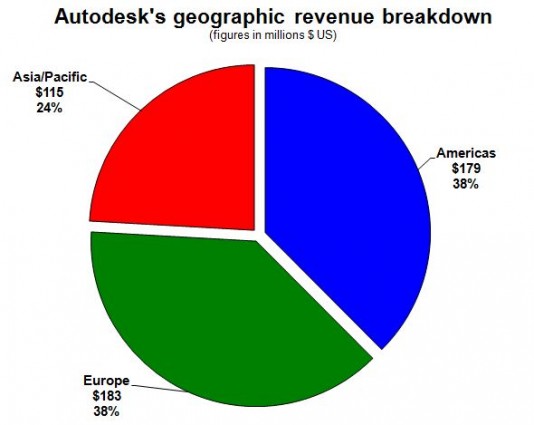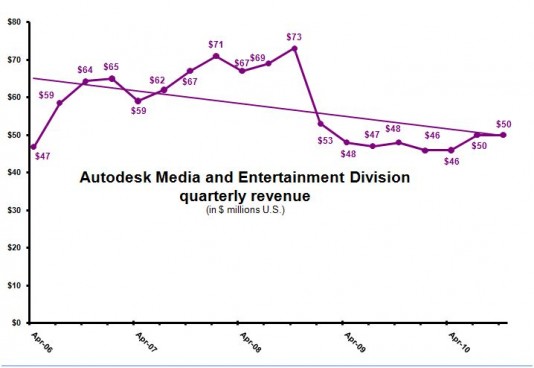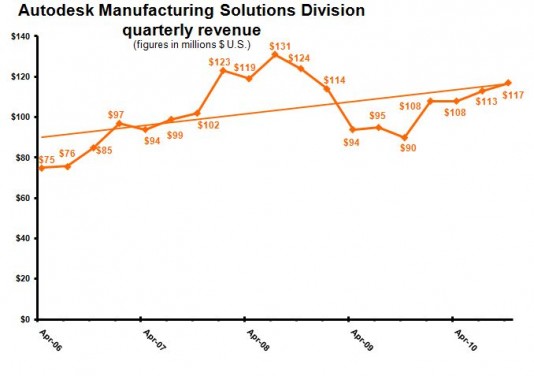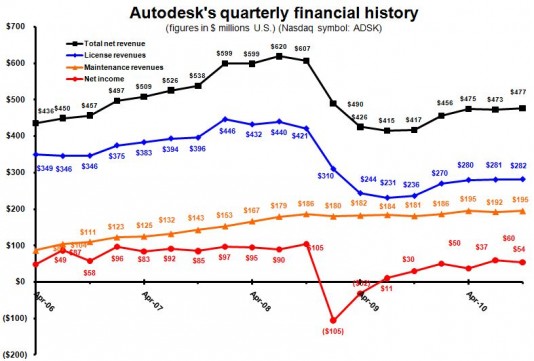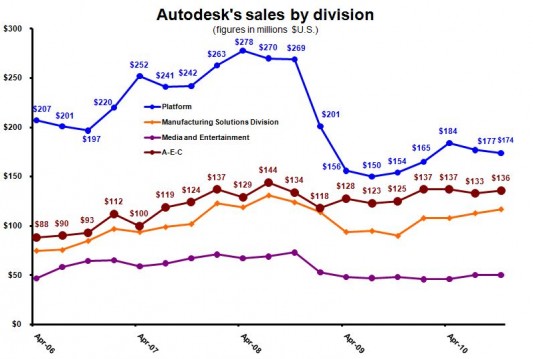For the first time in three years all geographic regions reported double-digit growth. CEO Carl Bass used the analyst Q&A to accuse rival Dassault Systèmes of ‘growth by obfuscation.’
Autodesk (NASDAQ: ADSK) has reported encouraging financial result for its third quarter, ending October 31, 2010. Net income was up 81% to $53.6 million on revenue of $477 million, up 14% compared to a year earlier. Autodesk said this was the first quarter in three years in which it saw double-digit growth (greater than 10%) in every geographic region when compared to the year prior.
Like its competitors, Autodesk has rebounded nicely from the recession. One metric we don’t normally use, cash flow from operating activities, shows just how far Autodesk has come. The figure for this quarter is $114 million, compared to only $47 million in the third quarter last year.
Revenue from new licenses (software sales) was $282 million, up 19%. Maintenance revenue was $194.7 million, up 8%.

Operational Overview
By geographic regions:
- Europe Middle East Africa (EMEA) revenue was $183 million, up 15%, 19% on a constant currency basis.
- Americas revenue was $179 million, up 10%.
- Asia Pacific was $115 million, up 22%, or 19% on a constant currency basis.
- Revenue from Autodesk’s “emerging economies” was $76 million, up 23%, 25% on a constant currency basis. Revenue from emerging economies represented 16% of total revenue in the third quarter.
Constant currency calculations are a way to compare sales from one quarter to the next by removing the impact of foreign currency fluctuations. Doing so also removes any gains or losses recorded to revenue in the current period as a result of Autodesk’s hedging program. Autodesk says it does not hedge currencies as an investment, but only to protect itself from fluctuations.

By business segments:
- Revenue from the Platform Solutions and Emerging Business segment (mostly AutoCAD and LT plus a variety of new small products) was $174 million, up 12%.
- Revenue from the Architecture, Engineering and Construction (AEC) business segment was $136 million, up 9%.
- Revenue from the Manufacturing business segment was $117 million, an increase of 30%
- Revenue from the Media and Entertainment business segment was $50 million, up 5%.

Cash per share
Autodesk’s cash and investments balance at the end of the third quarter was over $1.3 billion, for a cash per share of $5.00, up from $4.77 three months ago when Autodesk moved millions into long-term investments. Six months ago cash per share was $5.40, a more normal figure for the company. Compare this with Dassault Systèmes, which most recently posted cash per share of $10.97, and PTC at $1.88.
During the quarter:
- 33% of total revenue came from AutoCAD and AutoCAD LT;
- 30% of total revenue came from model-based design product (such as Inventor and Revit)
- 16% came from “emerging economies.”
Suite deals
Autodesk is focused on repackaging their broad line of products into as many suites as possible. It is a strategy that has done well for the likes of Ansys, Microsoft, and Adobe. In the third quarter, suites accounted for $107 million, up 24% from a year earlier. This amounts to 22% of total revenue.
In addition to enlarging average revenues per new license sale, (as Adobe has found with its Creative Suites) Autodesk suites should also increase its lucrative maintenance business. The company has not completed its full launch of suites; it expects to do so by the end of 2Q12 (May 2011).
Carl Bass aggressive chatter
During the quarterly conference call with Wall Street analysts, Carl Bass fielded questions about Autodesk’s competition. He says Autodesk is leading the way in combining parametric and explicit modeling, and accuses Dassault Systèmes of ‘growth by obfuscation.’ Excerpts from the discussion:
On Dassault Systèmes: “[In manufacturing] the company we compete with most is Dassault, and I think we are doing really well against Dassault. You know, Dassault seems to have a growth strategy by obfuscation. They are trying to grow by obfuscating financial results. They are not really growing, they are kind of losing in the market. I think that’s the place where we are really doing the best. … Gravity is on our side in the market. We have better products at better prices and more compelling value to customers, generally. It has certainly taken us a while to get that message in the market, but we are seeing great success with it. Our singular focus on helping customers build better products is really working, where I think others [focus] are a little more scattered.”
On Ansys: “I think Ansys continues to be a great company, they are doing really well. In many ways we are much more complimentary than we are competitive with Ansys. Do we have some areas in which we compete against them? Absolutely, as simulation is part of digital prototyping. But I see us as being less competitive and serving different parts of the market.”
On the competition in manufacturing CAD: “We think we are incredibly well positioned compared to the legacy providers. It fits into the wheelhouse of what we do, which is provide better functionality and much better value against older entrenched competitors. I give us credit more for sticking with the same strategy even through the downturn and in some ways increasing our investment on it, more than any particular thing we did this quarter. I’m really pleased, it is really gratifying to see the results.”
On the merger of parametric and explicit modeling: “We’ve led the way here. As often happens when you innovate in a competitive market, people follow you. So we have a bunch of competitors trying to do the same stuff. We feel really confident about the technology that we have. I think the important thing about any kind of modeling system, is there are certain things that are easy to do, and parametric modeling has stood the test of time. There are certain things where direct modeling is better. What we really did in [Inventor] Fusion is get this hybrid in which you can get the best of both, and that the user operate seamlessly together. I think some of the innovations are in each of the individual systems. But what I think what we’ve done particularly well is the combination of the two. Do I think it is a big deal, in that a lot of companies will offer something like that? I think our implementation is better and we’ve been in a leadership position with it.
“What gets interesting in the markets is when you look at them over time, is that innovation is coming from the volume provider. We’re the ones doing the innovative stuff, as opposed to the ones who liked to segment this market into high-end and mid-market or whatever euphemism they like to use. The innovation is coming from the volume provider, and I think that’s just the nature of software, and about returns going to the volume provider. “
What we think
Because of its large stake in retail sales, Autodesk was hit the hardest by the recession compared to its rivals. But its recovery has been as strong, and perhaps stronger, than the PLM leaders.
Regarding Bass’s claim that Autodesk is leading its competitors in the merging of parametric and explicit modeling, we think SpaceClaim and Siemens PLM, in particular, would beg to differ. This is not the first time an Autodesk executive has played fast and loose with CAD industry history. For years Jay Bhatt claimed Autodesk invented the term Building Information Modeling, when in fact a variety of researchers and journalists (including yours truly) were using the term before Autodesk adopted it.
During the recession, Autodesk stopped acquiring small companies. We think this will change in 2011.
Six charts follow.
Contributing Analyst L. Stephen Wolfe, PE contributed research for this report, even though it meant filing from an airport waiting room.


